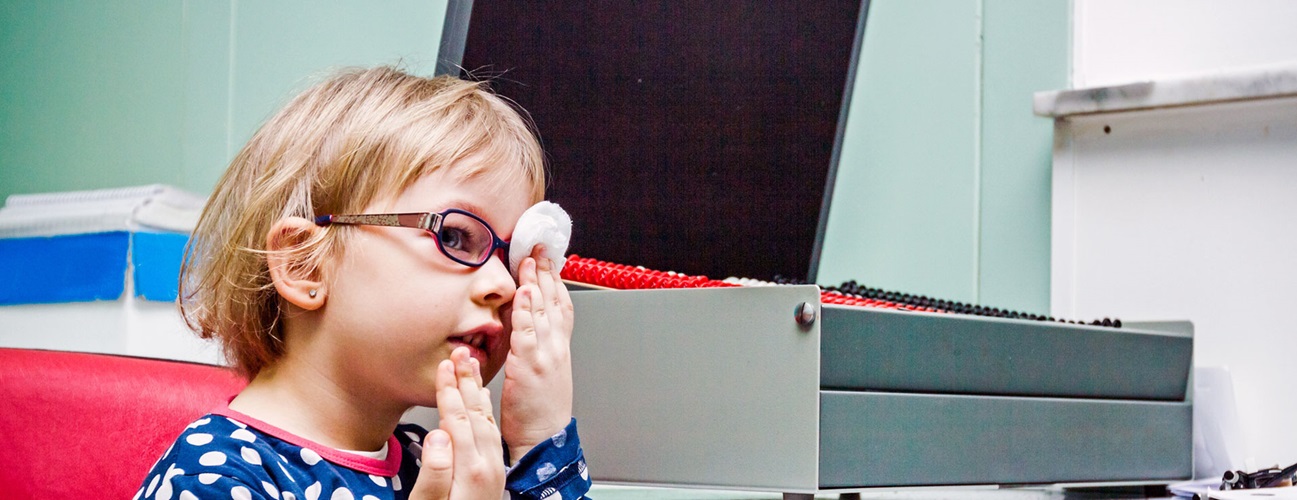Lazy Eye (Amblyopia)
Featured Expert:
What is amblyopia?
Lazy eye, also known as amblyopia, is one of the most common eye disorders in children. Lazy eye occurs when vision in one (or possibly both) of the eyes is impaired because the eye and the brain are not properly working together. This condition is sometimes confused with strabismus, also known as a misalignment of the eyes.
What is the risk of developing lazy eye?
Lazy eye is present in approximately 2%–4% of the U.S. population. The risk of developing the condition increases if a child:
- Is born prematurely
- Experiences a development delay
- Has a family history of lazy eye
What causes lazy eye?
There are three known causes of lazy eye:
Strabismus: Known as strabismic amblyopia, a misalignment of the eyes causes the brain to ignore input from the askew eye in order to avoid the confusion of double vision in a young developing brain. This eye then experiences a drop off or total loss in visual acuity as the brain favors the eye that is straight.
Refractive errors: Known as refractive amblyopia, poor visual development is caused by a difference in the amount of refractive error between the eyes. Although the child may have correct eye alignment, he or she may experience substantial nearsightedness, farsightedness and/or astigmatism in one eye, while experiencing none of these symptoms in the other.
When this happens, the brain becomes dependent on the better eye, while largely ignoring the issues of the eye with more refractive error. This leads to a lack of use and amblyopia in that eye.
Obstruction of vision: Known as deprivation amblyopia, the obstruction of light from a child’s eye prevents the development of proper visual acuity. This can be caused by:
- Cataract (a cloudy lens)
- Droopy eyelid (ptosis)
- Corneal scar
How is lazy eye diagnosed?
Lazy eye is diagnosed through a routine eye exam. Your child’s first eye exam should take place between the ages of 6 and 12 months old. Pediatricians routinely screen for general eye problems.
Lazy Eye Signs and Symptoms
Signs and symptoms of lazy eye include:
- Misalignment of the eyes, or strabismus
- Poor depth perception and peripheral vision
- Repeated eye closure or squinting
- Eyes that don’t move in the same direction when the child is trying to focus.
- A persistent head turn or head tilt
- Persistent shaking of the eyes
Lazy Eye Treatment
Lazy eye is generally treated by forcing the nonworking eye to work more actively. Lazy eye should be treated in early childhood to prevent it from becoming permanent, but studies have shown that older children may also benefit from treatment.
Eye patch
The standard treatment method for lazy eye, an eye patch is placed on the stronger eye in order to restore the brain’s attention to the visual input from the weaker eye. This allows proper visual development to occur in the weaker eye.
Corrective lenses and glasses
When dealing with lazy eye from refractive errors, vision restoration can be achieved with vision correcting glasses or contact lenses.
Atropine eye drops
Similar to the patch method, this treatment is administered in the form of eye drops into the stronger eye, which temporarily weakens its vision. This restores the connection between the brain and the weaker eye to strengthen its visual input.
This treatment involves constant dilation of the strong eye, which can bring about light sensitivity and difficulty in clearly seeing near objects during treatment. This form of treatment is most useful for farsighted prescriptions.
Surgery
Treatment of strabismic amblyopia often involves strabismus surgery to align the eyes. This surgery is typically followed by additional treatment methods such as the use of an eye patch on the stronger eye, atropine eye drops to the stronger eye, and/or eye therapy exercises to strengthen the weaker eye. In some cases, more than one strabismus surgery may be needed.
Treatment of deprivation amblyopia will usually require an operating room procedure, such as cataract surgery, droopy eyelid surgery or the surgical removal of corneal scars.







